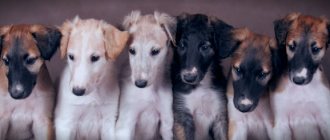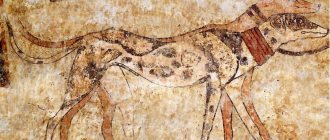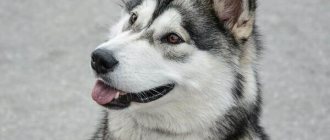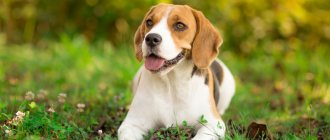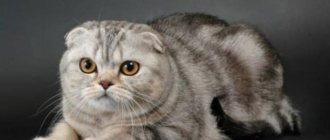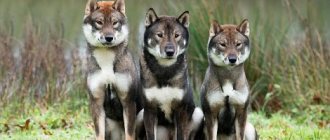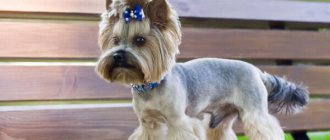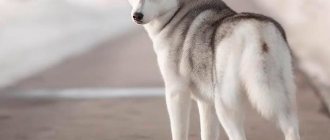The Russian Greyhound represents aristocracy and elegance among dogs. Looking at the representatives of this breed, it’s as if you yourself find yourself in the last century, when their distribution was especially popular. The greyhound's unique speed qualities, strength and endurance, and bright appearance - all this makes it popular today. Future owners often ask a lot of questions regarding the peculiarities of keeping and raising dogs. After reading the article, you will learn interesting facts about the origin, upbringing and characteristics of the Russian Greyhound breed.
Description of the Russian Borzoi breed
Popularity 77th place among 263 dog breeds
Lifespan:
10-12 years
Breed group:
Greyhounds
Height:
males: 75-86 cm, females: 68-78 cm
Country of origin:
Russia
Average price:
30-50 thousand rubles
Weight:
males: 35-45 kg, females: 25-40 kg
Latest articles Cat health
Ataxia in cats: what it is, how it manifests itself and is treated 01/23/2022 151 0 0
Cat health
Leukemia, or viral leukemia in cats 01/23/2022 140 0 0
Advantages and disadvantages
- Pros:
- elegant and aristocratic appearance;
- the calmness and love of lying in one place, which busy or phlegmatic people will appreciate;
- has excellent hunting skills, including impressive running speed;
- friendly to people, but not intrusive.
- Minuses:
- the hunting instinct is highly developed: the dog will pursue any target during a walk and will not get along with cats, birds and rodents;
- requires spacious housing and a separate corner in the house;
- poor security skills;
- requires frequent walking and being in the fresh air.
Character and behavior
The Russian Greyhound has a balanced temperament, friendly, sensitive and calm until it sees potential prey. At work, passionate and playful. Eating behavior is separated from hunting behavior; the dog does not eat prey; after suffocating it, it calms down and loses interest in it. Independent, but knows her place in the family. Gets along well with other pets, including small ones. Small dogs and cats outside the yard are often regarded as potential prey. Aggression is completely suppressed, protects its territory from other dogs, but not from people, very trusting, can leave with a stranger. Gets along well with children of any age, but is not well suited as a playmate.
The Russian greyhound combines two natures. On the one hand, this is a calm, affectionate home friend who loves comfort and attention, but on the other hand, this is a persistent hunting dog, which, at the sight of a wild animal, turns into a bundle of energy, quickly pursues its target and attacks with furious anger. At home, she is constantly looking for company, but when free, she takes off running at the first opportunity and seems to forget about the existence of the owner. Although many greyhounds return when called.
In principle, the working greyhound is independent in terms of life support. She is able to feed herself, at least she was able to at the time when the breed was being formed. This is reflected in her character and proud independence. Modern greyhounds are often freed from hunting duties, but it is not so easy to free themselves from a temperament that has been shaped over centuries.
She only agrees to a partnership relationship with the owner.
Sometimes owners of Russian greyhounds are faced with a problem that is popularly called “casualism”. In other words, this is the persecution of small domestic animals, including farm animals. To some extent, the hunting instinct is to blame here, but more often the reason lies in insufficient physical activity and poor socialization. Rarely, there are dogs that neither professional training nor persuasion can help wean from such behavior; all that remains is total control.
A dog's participation in hunting, coursing or racing does not affect its attitude towards small dogs, cats and other animals other than wild ones.
Key facts
It is obvious that the Russian dog was bred for hunting: to this day it is used as a tireless pursuer. The dog reaches speeds of up to 60 km/h, which allows it to drive both small and large animals. Russian greyhounds can even participate in wolf baiting due to their size, speed and endurance.
If you are getting an animal for your home, be prepared for training: the greyhound’s energy will require an outlet. The best exercise for her is chasing, stalking and playing hide and seek.
The Russian dog is an excellent companion for a calm and balanced person. The dog has a sanguine type of character, sometimes giving a tendency towards phlegmatism. She gets along well in an apartment, provided that she is given a spacious corner. The dog does not have the habit of disturbing its owner by barking or excessive importunity.
The Russian Greyhound is quite clean: when the coat is dry, it does not have the characteristic dog smell. In general, the behavior and appearance of a greyhound speak of aristocracy and self-esteem, which cannot be combined with unkemptness.
Interesting!
The name of the breed is derived from the word “dog”: it is soft and thin wavy wool. Today, the fringes on the chest, paws and tail are called dog feathers.
The hunting instinct in a greyhound is very strong, so you should not keep it with cats and other small animals. There is an option to “place” a greyhound puppy with an already adult cat: then the mustachioed pet will not make the dog want to hunt. But this does not apply to other people's small animals.
For the same reason, you should not walk with a Russian dog without a leash: she can start chasing at any moment, and no commands will stop her.
The greyhound is wary of small children: they can offend her with disrespectful behavior. Most likely, the animal will not harm the child, but it will be uncomfortable for him to exist with the kids. So it’s better to wait until your children reach school age and then get a Russian greyhound.
The description of the character of the Russian greyhound tends to indicate that the dog’s disposition is quite soft and pleasant. She senses the owner’s mood well, adapts to the rhythm of his life and treats him with trepidation. She is also friendly and sociable with other family members - of course, subject to mutual respect.
Photo and video review
The greyhound is often confused with the Russian hound. These are different but similar breeds. The latter, according to its name, only drives the prey, while the greyhound catches and kills the caught game. Photos and videos of Russian greyhound owners will help you understand the intricacies of the breed.
History of the origin of the Russian greyhound
Lean, large greyhounds appeared in Rus' during the reign of Ivan the Terrible - according to some versions, they were brought from Persia and the Kazakh Khanate. The king was fond of hunting, and fleet-footed animals came to his court. But the first documented information about Russian dogs dates back only to the 17th century.
They were bred, of course, by the nobles: they were guided solely by their own preferences. Matings took place with many types of greyhounds - Hort, Crimean, English, mountain and others. Despite the confusion among dissimilar individuals within the same breed, a standard was achieved quite early - in 1888.
However, the debate about how to bring the Russian dog to a single exterior continued for a very long time. Only at the beginning of the 20th century were the Russians able to agree on what the “model greyhound” would look like.
I should have stopped here, but no. The twentieth century turned out to be very difficult for the whole world, and especially for Russia. After the revolution, the number of individuals decreased sharply, and this is not surprising: who needed the dogs of aristocrats? And hunting with a pack was considered a relic of the tsarist regime.
Just when connoisseurs saved the breed, World War II broke out. After it, there were too few individuals left... But there were enough of them to restore the breed and bring it to the previously approved standard.
True, now graceful dogs do not always participate in the hunt. They were finally seen as excellent companions. And when the Russian dog came to the USA and Canada, there it was completely accepted as an “image” dog - like a Yorkshire terrier, for example. Only more impressive in size.
The history of Russian greyhounds is definitely not an easy one. Now this breed is quite popular both at home and abroad. It is used for hunting, in sports, and also just for fun. Because long-nosed greyhounds are just so cute.
Story
Russian greyhounds appeared after the Mongol-Tatar invasion. Then large and clumsy dogs, which had nothing to do with hunting, crossed with local shepherd dogs. As a result, after several decades, representatives of the breed not only acquired thick, silky hair, but also became graceful and hardy. The first representatives of the breed appeared in the 16th century in the forests of the Siberian taiga.
Such animals were especially revered in houses of noble origin. Rich families allowed themselves entire packs and raised puppies to hunt for fun. During the revolution, the breed was almost destroyed. The Bolsheviks, who considered expensive dogs a bourgeois habit, killed them in the hundreds. Breeders managed to restore the breed thanks to individuals taken abroad as gifts.
Despite such a long origin, the breed was recognized only in the middle of the 20th century. In Russia, greyhounds are used for hunting, unlike in the United States, where the animals are kept as beloved pets despite their impressive size.
Appearance of the Russian Borzoi
General impression
Like all greyhounds, our Russian hound is a model of elegance and grace. A true supermodel in the animal world. Despite his high height (almost 90 cm at the withers), the dog does not look huge, much less massive.
Not only her body is graceful, but also her movements. The Russian greyhound, like any hunting dog, can sneak silently and rush faster than the wind, barely touching the ground with its paws.
Head
The skull is narrow and elongated, especially in profile. The stop (the transition from the forehead to the nose) is poorly expressed, but the back of the head has an obvious rounded shape.
Nose, eyes and ears
The nose is sometimes so long that it is very difficult to resist making jokes. And the lobe is also actively moving! Looks very, very funny.
Sometimes, if you look closely, you can see a hump on the bridge of your nose. And this will not be considered a vice.
The eyes have an almond shape and a deep brown color. Other shades of the iris will be considered a defect.
The ears have thin cartilaginous tissue, so they are in a hanging position. However, they quickly get up if their owner is alert and listens. The ears themselves are placed close to the back of the head.
Teeth and bite
The Russian Greyhound breed standard does not strictly regulate the bite: it can be either straight or scissor. Both options are valid.
Neck
Visually, the neck does not seem thin and long - but only because of the fur. In fact, she is very graceful, without a single fat deposit. If you look closely, it is slightly flattened on the sides - you get the feeling that it is slightly rectangular.
The withers are weakly expressed, the skin on it is not as thick as that of some other breeds.
Torso
Any greyhound is lean and elongated. The Russian dog is no exception.
The dog's chest is oval and deep, clearly visible. But at the same time, if you look from the front, you will notice that it is not wide. Like the neck, it is slightly flattened on the sides and does not protrude beyond the line of the entire body.
The back is long and slightly hunched, which is better visible in males. The croup is elongated and sloping, the pelvis is narrow but strong.
Forelegs
The muscles on the dog's paws are clearly visible. It should be noted that both the front and hind limbs are dry.
The elbows point straight back, the joints of this breed are well defined. The shoulder blades are sloping, tucked near the body.
Hind limbs
They are set wider than the front legs and are longer themselves. The hock joint is located low, the paw itself is tightly gathered into a ball. The thigh has very strong and well-defined muscles.
Tail
The saber-shaped tail is very long, but at the same time thin. It is located low relative to the croup. According to the standard, there should be noticeable pubescence along the bottom.
Movements
The running of a Russian greyhound in everyday life - during walks and warm-ups - is an easy trot. The dog moves quite smoothly and measuredly, watching it is a pleasure.
But with persecution, everything changes. The Russian dog is being transformed: wide, spasmodic movements are swift and impeccable. The hind legs are ahead of the front legs. In this “mode” the dog can reach a maximum speed of up to 90 km/h, and an average of 55 km/h.
Wool
The coat consists of elongated, noticeably wavy and fine hairs. In some places they form curls. But on any part of the body the fur is soft and silky to the touch. It has the ancient name “dog”.
The fullest areas are the “pants” and the scruff of the neck. Long hair also grows on the underside of the tail and belly.
Color
The colors of the Russian dog allow for a wide variety: only “chocolate” and any variations of a blue tint are considered defective (as they may indicate poor health of the animal).
Allowed are both solid (monochrome) and piebald (brindle, tan, marbled), saddleback, spotted in any variations. The Russian Greyhound can be white, reddish, gray and silver, reddish brown.
Fans of the breed use ancient terms to designate the colors of these noble dogs: murugi, forelock, burmat, sex. And the mask on the face has its own, also ancient, name - mazurina.
Size
These dogs are tall but lean animals. There is no feeling of massiveness when looking at them. However, the wavy coat adds volume to them, so the dogs do not look too thin.
The tallest males reach approximately 85 cm at the withers, females are slightly lower - up to 78 cm. Weight ranges from 35-45 kg for males, and females are much lighter - 25-40 kg.
Disqualifying faults
You will not be allowed to attend exhibitions if you have the following defects:
- not brown eye color;
- asymmetrical bite and incomplete dentition;
- blue or brown (without redness or redness) coat color;
- dewclaws;
- size too small;
- aggression or cowardice.
Minor faults include a hard coat, too light a bone, a non-black nose and too pronounced withers, as well as a short tail and an insufficiently retracted belly line.
Breed standard
All parts of the Russian Greyhound's body indicate that such a dog is created for rapid running. From its European ancestors, the Russian greyhound inherited a sweeping run, an arched back, small ears and a narrow, long head. Asian ancestors inherited an imperturbable, proud disposition.
The main differences of this breed are: aggressiveness towards animals, excellent eyesight, great speed, narrow build, large stature, elegance. The height of adult individuals is about 68-86 cm , weight 25-47 kg.
A long neck holds a narrow, long head with a flat skull. The ears are small and set high. The dark eyes are quite large, oval, slightly protruding. The nose is large, with wide open nostrils. The jaws are powerful, the fangs are large and white. Scissor bite or straight bite. The chest is not wide. The belly is tucked, which is typical for all types of greyhounds. The tail is thin, long, saber-shaped or sickle-shaped. During movement, the Russian greyhound raises it, but not higher than the level of its back.
The limbs are bony, smooth, with well-developed muscles. The paws are narrow, oval in shape. A light step and an extremely beautiful trot are quite justifiably the hallmark of the Russian Borzoi.
The coat is thin, there is no undercoat. Can be long, silky or stiff and curly. On the neck and back the hair is wavy and longer. Almost any color is allowed. Most Russian greyhounds are white-spotted. Greyhounds with dark coats have “mazurina” - blackness of the muzzle. Bright spots on the body are a serious drawback.
Similar breed: Afghan Hound
Character of the Russian Borzoi
These dogs are full of opposites and paradoxes. The first thing you might be surprised by is the change in their activity. On the street, at competitions and championships, they turn into fanatical pursuers, real racers. It seems that their energy is inexhaustible. But at home...
At home, these aristocrats follow the best Oblomov traditions. They happily lie on soft pillows around the clock. By the way: greyhounds will quickly learn to beg for their owners to let them onto the bed or sofa. If you don’t like this, initially don’t let the puppy go anywhere other than his place.
“ It also happens that it is simply impossible to take a Russian dog out for a walk - especially if there is bad weather outside.
That is, if you take a Russian dog for a good walk and let it run around, it becomes a real angel at home. The dog does not damage furniture, does not chew shoes and generally does not play pranks.
Like a true nobleman, this dog does not like noise, harsh sounds and fuss. Therefore, small children and overly active small pets are far from their favorites. It is unlikely that the greyhound will offend them, but it will definitely not communicate with troublemakers. And the dog itself will not make noise; barking or fussing is not in its habits.
Speaking of small pets: rodents, birds and even cats can become prey. Because the hunting instinct of greyhounds is still very strong.
But the greyhound is friends with other dogs. She is not prone to aggression, so she can behave very calmly on walks - unless a GOAL appears on the horizon.
The Russian dog's intelligence is high, but it is difficult to train. More precisely, she learns baiting and hunting very quickly, but commands and tricks are not her strong point. Still, this dog was bred as a pursuer, which means that independence flows in its blood.
“ But this does not mean that she is stupid - the greyhound understands everything perfectly. He might just be a little willful.
The pet is affectionate and friendly with its owners. Her obedience is on par; this dog is not used to dominance. Perhaps in adolescence, male dogs can test a person’s strength - but this stage quickly passes.
Dog health
Russian greyhounds are predisposed to ophthalmological diseases, gastric and intestinal volvulus, Wobbler syndrome, and tumors (both benign and malignant).
Animals are hypersensitive to anesthetics and some flea and tick medications.
Therefore, you should be responsible and careful when choosing protective equipment, after consulting with your veterinarian.
Photo: https://www.flickr.com/photos/ferlinka/6094314651/
Greyhounds are very sensitive to infectious diseases, so it is imperative to vaccinate them!
Before each vaccination, it is necessary to carry out deworming, which it is advisable to repeat quarterly thereafter.
Education and training
It was said above that the intelligence of a dog of the Russian Greyhound breed is high. It will be quite easy to teach her hunting tricks. Simply because this dog has a developed instinct. She also makes an excellent companion, as the dog behaves with restraint and dignity at home.
Companion dog
The Russian dog is a rather sensitive and empathetic creature. In addition, it does not make noise, does not spoil things and does not create chaos in the house. Sweeping away everything in its path to meet its owner - only teenagers are capable of this. Adults behave with dignity and aristocratically.
In terms of character, Russian dogs are somewhat similar to small, decorative dogs: Pekingese, Shih Tzu, lapdogs, Yorkies. They have the manners of courtiers and like to be treated delicately.
At the same time, the greyhound is not required to have perfect obedience and phenomenal training - like, for example, a service shepherd dog or a Doberman. If you direct her energy in the right direction, your pet will be a real bunny at home.
“ However, you still need to teach this dog commands. Moreover, you must act carefully: the delicate animal will not tolerate sharp shouts, tugging on the leash, or humiliation. Train him gently but persistently.
The main emphasis is on curbing the hunting instinct. The dog must learn to stop chasing at the owner's command. Otherwise, any walk will turn into a real test - the greyhound will chase all the cats in the area until exhaustion.
To achieve obedience, you need to spend your pet's energy well. An excellent solution is to enroll him in coursing, agility and other running canine sports.
Hunter dog
The special training of greyhounds is called packing - this is the ability to work in a pack. They begin to practice the skill when the puppy has reached about 10 months and has learned the basic commands.
The pet is taught to move around other dogs, a horse or a bicycle. During the training process, the animal looks at more experienced “comrades-in-arms” and learns to prowl. An experienced “hunter” can conduct a solo hunt, without a pack.
It is very important to wean a greyhound from aggression - both towards game and towards its pack mates.
“You cannot let a dog tear and tear caught game. On the command “No” (or, in the hunting style, “Open”), she must give up the prey.
Also, you should not encourage dogs to “fight” among themselves in a pack. Contrary to the opinion of some hunters, anger does not add strength and excitement during pursuit. Instead, the animal develops misconceptions about social norms and becomes difficult to control.
Features of hunting
The puppy is taught to hunt from an early age. It must be accustomed to the sounds of a special trumpet that is used to catch prey.
The owner needs to train the animal to strict restraint so that the dog does not start eating without permission and a clear command.
Previously, the breed was kept specially and hunted with them often. Now it is necessary to take care of your pet’s stamina and subject it to daily physical activity, otherwise it will lose its natural qualities and gain excess weight.
From the age of two months, the puppy is taught to respond to its name, walk on a leash, and follow basic commands. It is best to raise a child in natural field conditions. Greyhounds are trained using training, most often for a hare or fox, less often for a wolf. The young hunter is given experienced animals as an example. If the puppy is not trying to kill, but is only playing with the prey, the adult dog should teach him how to deal with the caught animal. It is important to awaken the puppy’s natural instincts.
Health and disease of the Russian greyhound
Possible diseases
The Russian Canine is a relatively healthy dog breed. But at the same time, it is sensitive to irritants. This means that she is prone to allergies: both food and skin. When introducing new products or food, you should carefully monitor the body's reaction.
Also, a greyhound can suffer from incorrectly selected anti-parasitic agents. Choose soft medications and collars for sensitive animals. Give your dog medications with extreme caution - many analgesics and anesthetics can cause serious problems, including death.
A few more points that are noticed in Russian greyhounds:
- retinal problems and cataracts;
- sensitive digestion, reacting sharply to overload and fatty foods;
- Wobbler syndrome (pinching in the cervical spine);
- joint problems in adolescence.
The latter involves careful care of puppies during their active growth period. They should not be allowed to climb stairs on their own, jump off and onto high objects.
Reproductive health and breeding
Traditionally, bitches are bred only on their third heat – at this point the expectant mother’s body is ready to bear healthy offspring. Males must reach at least one and a half years of age, or better yet, two years.
Mating takes place in the male dog's territory. Before this, the owners of the partners must check each other’s documents: pedigrees and health certificates. Many diseases require exclusion from breeding (demodex, dysplasia, etc.).
Pregnancy lasts 60-67 days and ends with an easy birth. Bearing offspring in Russian greyhounds usually proceeds without difficulties, as does raising puppies. By the way, on average 6-10 babies are born.
Application
At home, a dog looks more like an expensive accessory lying in the middle of the room. An animal can remain in its place for hours without requiring any fuss around it. A little timid with strangers. But after a short acquaintance, she may begin to flirt with a new friend if she likes him. Greyhounds do not show aggression towards strangers without a significant reason.
Sometimes instincts overcome common sense
Dogs of this breed are sensitive, love affection, although they show restraint. But despite all the meekness of the pet, it is necessary to remember that the blood of a hunter flows in his blood. Therefore, you should not trust the Russian greyhound to a place where there is game. A pasture or a poultry yard will help her imagine that she is hunting. The consequences can be unpredictable.
Before you buy a Russian greyhound, it is important to assess your capabilities and willingness to spend all your free time with it.
Features of feeding and diet
Since the digestive tract of Russian Greyhound dogs is delicate, they need to be fed competently, strictly adhering to the basic principles:
- do not give fatty meat, preferring chicken, beef, rabbit or horse meat;
- add buckwheat or rice steamed with boiling water;
- treat him to cottage cheese, kefir, fermented baked milk, boiled egg - but not every day;
- pamper yourself with low-fat sea fish such as cod; squid can be offered as exotic;
- give up legumes and potatoes, replacing them with carrots, pumpkin, zucchini, herbs and some fruits;
- feed fractionally, 3-4 times a day - this is especially important for dogs engaged in hunting;
- do not mix dry and natural feeding;
- in the case of feeding on industrial food, choose a premium class, in addition to “drying”, sometimes treat with wet canned food from the same line;
- do not change the type of feeding unless absolutely necessary and always take the same food;
- introduce new foods and feeds gradually to check for an allergic reaction.
While the puppy is growing, its diet should be enriched with calcium and B vitamins. You cannot do this on your own: you must first consult a veterinarian.
Nutrition
Large individuals need sufficient food. The diet of greyhounds requires variety and good quality. These are very expensive animals to keep.
The table shows the main products and their processing options necessary for feeding a greyhound.
| Product | How to cook | What does the dog get? |
| Meat: beef, veal, lamb, horse meat | Only horse meat can be given raw; this meat is not affected by brucellosis. It is best to boil the remaining ingredients | Protein, vitamins |
| Fish – lean varieties (cod, pollock) | The animal should be fed boiled fish, having previously cleaned it of bones. | Protein, iodine, phosphorus |
| Eggs | Boiled. An adult dog should be given no more than two eggs a week, a puppy can have 3-4 | Protein |
| Vegetables and fruits | Your pet will benefit from vegetable and light soups. Hard raw vegetables are grated on a coarse grater, seasoned with butter or sour cream | Vitamins for healthy and shiny coats |
| Milk, its derivatives | Puppies benefit from milk porridge. It is better to give fermented milk products to adult dogs. In their pure form or as an additive to other foods, they are fed kefir, fermented baked milk, yogurt, and cottage cheese. Hard unsalted cheese is suitable for feeding | Calcium |
| Cereals: rice, buckwheat, rolled oats | Steam with boiling water or hot milk | Vitamins and microelements necessary for development |
You cannot feed the animal:
- bones;
- leftovers from the table;
- salty foods;
- flour products;
- fatty meat;
- offal;
- sweets;
- starchy vegetables and fruits;
- legumes
It is recommended to feed the animal by the hour; portions should be eaten to the end.
Care and maintenance
Space and habits
The Russian dog, despite its size and love to run, feels great in an apartment. The main thing is to give her a spacious corner in which she can stretch out to her full length.
“ Greyhounds love cushions, sofas and beds. Therefore, a simple bed is unlikely to suit the dog. Owners either have to accept the fact that the pet will be located nearby, on the sofa, or they will have to fork out for a dog sofa.
The Russian dog can also live in an enclosure. But then she will need a spacious and insulated booth, as well as a high and durable fence. And of course, the enclosure does not replace regular active walks.
Puppies and teenagers need toys, but an adult can do without them. Greyhounds' favorite pastime within the walls of the house is wallowing on something soft, contemplating and communicating with the owner (even silently).
Hygiene and grooming
The Russian greyhound does not smell like “dog” (this is a funny pun) - only if it is wet and has had a lot of exercise. This is a significant plus for an apartment dog.
These dogs don’t really like to bathe, but they don’t need to be washed often. For companion greyhounds, several full baths a year are enough; hunters should still be washed more often, at least once every 2-3 months.
“ During the molting period, dogs are brushed daily, the rest of the time - a couple of times a week. There are tangles, but not often.
If the dog is involved in hunting, then after forays into nature you need to inspect it. Pick out specks, comb out burrs, remove ticks.
In general, keeping a greyhound is not very tiring:
- wipe your eyes daily;
- clean your ears - but not with a cotton swab, but with a disk and a special zoo lotion;
- trim your nails if they are not worn down;
- Treat against fleas and ticks during the season;
- Get vaccinated once a year and dewormed once a quarter.
No special recommendations can be given here. Greyhounds are clearly not dogs that require grooming and a lot of clothes.
Walking and activity
The most important thing for dogs of the Russian Greyhound breed is active walks. Physical activity should be regular and intense.
This is not to say that Russian greyhounds are real energizers, far from it. They need regular walks, but they don’t have to “kill themselves” in sports activities.
“It is enough for an adult greyhound to walk a couple of kilometers at a leisurely trot, but a puppy, of course, needs to play with its owner.
Intense runs are also necessary, but not every day. It’s ideal if you can take your pet “out into the open field” and let him run around there. It’s great if you have the opportunity to sign up your pet for coursing - this is racing after a mechanical hare. Other competitions are also suitable: agility, greyhound racing.
Reviews
Our favorite Alma is a very fast, energetic dog. It is not easy and very expensive to keep such a large hunting greyhound in an apartment, but the baby has been with us for almost 10 years. Taking care of her disciplines the whole family, because every morning we go for a long run.
It is not recommended to buy a puppy not for hunting, but for apartment living. The pet will run after every cat or bird on a walk. Obedient within the walls of a house, but completely uncontrollable within the city. It is expensive to keep an animal, since a purebred and very large dog needs a balanced diet, especially good meat.
An ideal breed for baiting a hare or fox. The dogs Duke and Musketeer have been hunting with me for more than 7 years. I bought them as puppies from a reliable nursery. The breeder provided all the necessary documents. As a result, I have excellent hunting dogs. He raised and trained himself.
Before deciding to purchase a representative of this breed, you should think carefully, analyze the facts, and discuss your decision with family members. The greyhound dog is not included in the list of aggressive animals, but still is not distinguished by its submissiveness and docile nature. Expensive to care and maintain, she requires training, education, and time for communication.
Tips for choosing a puppy
You should buy a Russian Greyhound baby only in trusted places. If you want a hunter, contact kennels where working and sporting dogs are bred. If you need a show champion, look for a nursery with an elite focus. Well, if it’s a companion, then go to any responsible breeder.
The requirements for the baby and his parents depend on the class of the puppy:
- show (for exhibitions) - mom and dad are show champions, the puppy itself is at least six months old, with all documents, without defects;
- breed (for breeding) – one of the parents is a champion, a puppy over 3 months old without defects, with all documents;
- pet (for home and soul) – a puppy over 2.5 months old, with healthy parents, with minor deviations from the standard and without the right to breed.
The nursery itself should be clean, spacious, and visually pleasing.
“ Read more about what documents a dog should have
Which puppy should you choose? Decide based on your personality preferences:
- the most active and curious - for hunting and sports;
- affectionate and sociable - for extroverted owners, for teenagers;
- modest quiet - for introverted owners, for novice dog breeders.
Although they say that appearance is not the main thing, still look at the color. You should at least like him.
How to choose a puppy
- Choose February or March litters, the babies of which will be ready to move to a new home in May-June. In this case, you can diversify your pet’s diet with seasonal fruits and vegetables that contain most of the vitamins necessary for a growing body.
- Don't get hung up on a specific type of appearance of your future pet (for example, the owner breeds white dogs, but you want a gray one). The Russian Greyhound is one of the most diverse breeds, and each of its representatives is beautiful in its own way.
- If you hope to raise your puppy into a professional hunter in the foreseeable future, ask whether his parents have field diplomas. You shouldn’t delude yourself too much about hereditary talents either, since hunting skills are not always passed on from parents to children and largely depend on proper training.
- The appearance of a growing Russian Greyhound puppy is constantly changing, so choosing the most spectacular baby from the litter is unlikely to be possible. However, it is still worth visually assessing the correctness of the bite, the cleanliness of the dog’s meat and the general condition of the future pet.
